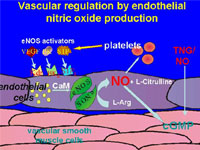
中科院上海药物所蒋华良研究员、罗成副研究员与美国弗吉尼亚联邦大学生化与分子生物学系Sarah Spiegel教授组成研究团队、开展合作研究再结硕果。继2009年在《科学》杂志发表“鞘氨醇磷酸酯(Sphingosine-1-phosphate, S1P)调控机制的研究”后,该研究团队在该领域再次取得突破性进展,研究论文于6月24日发表在英国《自然》杂志上。
相关阅读:Science:鞘氨醇磷酸酯调控机制的研究
该研究综合运用计算生物学方法和实验技术首次发现S1P是肿瘤坏死因子受体相关因子2 (Tumour necrosis factor (TNF) receptor-associated factor 2, TRAF2) 生理调节辅助因子。S1P最初发现与细胞生长的调节有关,它是一种存在于细胞核中具有生物活性的脂质信使,由鞘氨醇激酶亚型1(SphK1)产生。S1P通过TRAF2调控TNF-a和NF-кB信号通路,进而参与一系列炎症、抗凋亡和免疫反应。
生物谷启用新域名 www.bioon.net
该研究还阐明了S1P调控NF-кB信号通路的机制:S1P通过特异性结合在TRAF2的N-末端RING功能域上,激活其E3泛素化连接酶活性,进而催化完成RIP1蛋白上63位赖氨酸相连的多泛素化修饰。泛素化的RIP1可以通过招募并磷酸化激活IKK复合物,最终激活NF-кB信号通路。该研究圆满解释了SphK1和 S1P如何参与调控炎症、抗凋亡和免疫反应,发挥细胞保护作用的机制,揭开了科学家长期探索的谜底。
该研究团队综合运用理论和实验的手段研究生命科学复杂问题,表明理论科学与实验科学的有效整合,将极大地促进生命科学相关关键问题的研究。
该研究得到了科技部973计划项目、新药研究国家重点实验室的部分资助。(生物谷www.Bioon.net)
生物谷推荐原文出处:
Nature doi:10.1038/nature09128
Sphingosine-1-phosphate is a missing cofactor for the E3 ubiquitin ligase TRAF2
Sergio E. Alvarez,Kuzhuvelil B. Harikumar,Nitai C. Hait,Jeremy Allegood,Graham M. Strub,Eugene Y. Kim,Michael Maceyka,Hualiang Jiang,Cheng Luo,Tomasz Kordula,Sheldon Milstien" Sarah Spiegel
Tumour-necrosis factor (TNF) receptor-associated factor 2 (TRAF2) is a key component in NF-κB signalling triggered by TNF-α1, 2. Genetic evidence indicates that TRAF2 is necessary for the polyubiquitination of receptor interacting protein 1 (RIP1)3 that then serves as a platform for recruitment and stimulation of IκB kinase, leading to activation of the transcription factor NF-κB. Although TRAF2 is a RING domain ubiquitin ligase, direct evidence that TRAF2 catalyses the ubiquitination of RIP1 is lacking. TRAF2 binds to sphingosine kinase 1 (SphK1)4, one of the isoenzymes that generates the pro-survival lipid mediator sphingosine-1-phosphate (S1P) inside cells. Here we show that SphK1 and the production of S1P is necessary for lysine-63-linked polyubiquitination of RIP1, phosphorylation of IκB kinase and IκBα, and IκBα degradation, leading to NF-κB activation. These responses were mediated by intracellular S1P independently of its cell surface G-protein-coupled receptors. S1P specifically binds to TRAF2 at the amino-terminal RING domain and stimulates its E3 ligase activity. S1P, but not dihydro-S1P, markedly increased recombinant TRAF2-catalysed lysine-63-linked, but not lysine-48-linked, polyubiquitination of RIP1 in vitro in the presence of the ubiquitin conjugating enzymes (E2) UbcH13 or UbcH5a. Our data show that TRAF2 is a novel intracellular target of S1P, and that S1P is the missing cofactor for TRAF2 E3 ubiquitin ligase activity, indicating a new paradigm for the regulation of lysine-63-linked polyubiquitination. These results also highlight the key role of SphK1 and its product S1P in TNF-α signalling and the canonical NF-κB activation pathway important in inflammatory, antiapoptotic and immune processes.







